
James Barney Marsh was an American engineer and bridge designer. He patented a new design for arch bridges. Marsh gave Archie Alexander, the first African-American to graduate as an engineer from Iowa State University, his first job. Marsh worked in the bridge building business for over 50 years, and several of his bridges are listed in the National Register of Historic Places.
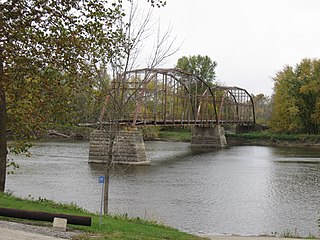
The Sutliff Bridge is a bridge over the Cedar River at Sutliff, a Johnson County community near Lisbon, Iowa, United States. A Parker truss bridge, it was built in 1897 and 1898 at a cost of approximately $12,000. J. R. Sheely was the engineer for the original Sutliff Bridge. After a modern replacement was built over the Cedar in 1983, the bridge was slated for destruction, but it was ultimately saved, and on May 15, 1998, it was added to the National Register of Historic Places.

The Bridgeport Bridge is a historic structure located near Denmark, Iowa, United States. This span was a replacement bridge for structure whose middle stone pier was deteriorating. The weaknesses in the old bridge were noted in 1887 and 1893. Both Des Moines and Lee counties financed the $5,110 construction of this bridge, which spans the Skunk River between the two counties. The 240-foot-long (73 m) Pennsylvania truss bridge was built in 1904 by the Clinton Bridge and Iron Works of Clinton, Iowa. It carried local traffic for nearly 90 years before it was closed. It has the distinction of being the longest pin-connected truss remaining in Iowa. The Bridgeport Bridge was listed on the National Register of Historic Places in 1998.

The Burlington, Cedar Rapids and Northern Railway (BCR&N) was a railroad that operated in the United States from 1876 to 1903. It was formed to take over the operations of the bankrupt Burlington, Cedar Rapids and Minnesota Railway, which was, in turn, the result of merging several predecessor lines, the construction of which began in 1869. The corporate headquarters were in Cedar Rapids, Iowa, and it had operations in Iowa and in Minnesota. It was succeeded by the Chicago, Rock Island and Pacific Railway.
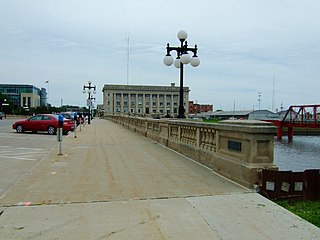
The Civic Center Historic District is located in downtown Des Moines, Iowa, United States. It flanks both the Des Moines and Raccoon Rivers and their confluence. The district has been listed on the National Register of Historic Places since 1988. It is part of The City Beautiful Movement and City Planning in Des Moines, Iowa 1892—1938 MPS.
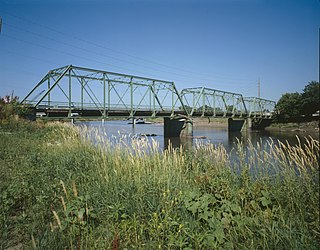
The Southwest Fifth St. Bridge is a historic structure located in downtown Des Moines, Iowa, United States. Built in 1898 after a controversy surrounding the bidding process, it is one of the last Pratt through truss bridges left in an urban setting in Iowa. The bridge was listed on the National Register of Historic Places in 1998 as a part of the Highway Bridges of Iowa MPS.

The United States Post Office is a historic building located in Des Moines, Iowa, United States. It was individually listed on the National Register of Historic Places in 1974. It became a contributing property of the Civic Center Historic District when it was established in 1988. It now houses administrative offices for Polk County.

The Upper Paris Bridge is a historic structure located near the town of Coggon in rural Linn County, Iowa, United States. The pin-connected Whipple through truss bridge was built in 1879 as a wagon bridge. It was designed by the Wrought Iron Bridge Company of Canton, Ohio. The bridge was listed on the National Register of Historic Places in 1998 as a part of the Highway Bridges of Iowa MPS.
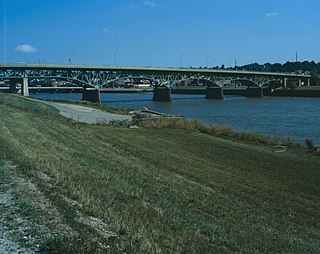
The Jefferson Street Viaduct is an historic structure located in Ottumwa, Iowa, United States. The riveted Warren deck truss bridge was completed in 1936. It was listed on the National Register of Historic Places in 1998 as a part of the Highway Bridges of Iowa MPS.

Downtown Des Moines is the central business district of Des Moines, Iowa and the Greater Des Moines Metropolitan Area. Downtown Des Moines is defined by the City of Des Moines as located between the Des Moines River to the east, the Raccoon River to the south, Center Street to the north, and 18th and 15th Streets to the west.

The Cascade Bridge is a historic structure located in Burlington, Iowa, United States. In April 1896 the Burlington City Council approved a proposal to have city engineer S.D. Eaton advertise for plans and estimates for a bridge on Main Street that would span Cascade Ravine. The Cascade Lumber Company had petitioned for the bridge. The city contracted with the Cedar Rapids, Iowa firm of Boynton & Warriner to design the structure and the Milwaukee Bridge and Iron Works to erect the span. The city was responsible for building the concrete substructure. The bridge was completed in the fall of 1896, and is composed of four spans. The span length is 160 feet (49 m), and its total length is 464 feet (141 m). The span is a Baltimore deck truss bridge with Pratt deck trusses at both ends. The structure is supported by stone and concrete abutments with concrete pedestals and a single concrete-filled steel cylinder pier. Over the years the original deck has been replaced, and concrete has been applied to the stone abutments. Otherwise the structure has been unaltered. The bridge was listed on the National Register of Historic Places in 1998.

Ellsworth Ranch Bridge is a truss bridge located 7 miles (11 km) northwest of Armstrong in rural Emmet County, Iowa, United States. The Emmet County Board of Supervisors received a petition in January 1895 for a bridge across the East Fork of the Des Moines River in Lincoln Township. They gave their approval in April of the same year, and in May the board adopted the plans of the King Bridge Company of Cleveland, Ohio. However, they rejected all the bids as too high, so they reduced the length of the span from 100 feet (30 m) to 80 feet (24 m). King won the contract for this and two other bridges for $3,400. The Ellsworth Ranch Bridge was completed later in 1895. The bridge includes elements of both the Pratt and Warren configurations in its single span. A minor reconstruction was completed in 1937, and it was listed on the National Register of Historic Places in 1998.
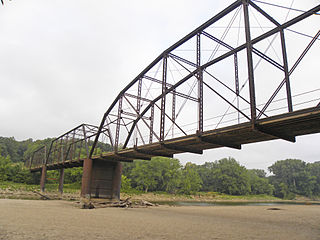
Boone Bridge 2, also known as the Wagon Wheel Bridge, was a historic structure that was located west of Boone, Iowa, United States. It spanned the Des Moines River for 703 feet (214 m). The Boone Commercial Association and the Boone County Board of Supervisors disagreed over the location of a new wagon bridge over the river. The county wanted the new bridge west from Eighth Street in Boone, closer to the Chicago and North Western Railroad's Boone Viaduct. The businessmen wanted to rebuild the Incline Bridge. The dispute was resolved when the Commercial association offered to buy the Incline Bridge. The county contracted with the Iowa Bridge Company to design and build the bridge, which was completed in 1910 for $77,900. The bridge consisted of a long-span Pennsylvania truss over the main channel of the river and three Pratt trusses over the floodplain. It was listed on the National Register of Historic Places in 1998.

The Nishnabotna River Bridge is located southwest of Manilla, Iowa, United States. It carries traffic on 310th Street over the Nishnabotna River. Steel was in short supply during World War II as a part of the war effort. Many bridges built across the state were built in this era with timber, especially small-scale bridges. Heavy flooding washed out 27 bridges and culverts in Crawford County in May 1945. The county board of supervisors used emergency funds to build new bridges. They bought several steel superstructures from the Des Moines Steel Company to replace the wash-out spans. The bowstring arch-truss structures appear to have been designed by H. Gene McKeown, a civil engineer from Council Bluffs. This bridge is one several similar structures built in the county, and one of five that still remain. The bridge was listed on the National Register of Historic Places in 1999.

The Marsh Rainbow Arch Bridge, also known as the Coon River Bridge and Rainbow Bend Access, is located south of Lake City, Iowa, United States. The 271-foot (83 m) three-span bridge carried traffic on Iberia Avenue over the North Raccoon River. It was designed by Des Moines engineer James Barney Marsh in his patented rainbow arch configuration, and constructed by the Iowa Bridge Company in 1914 for $10,970. It replaced a Howe truss bridge that had been built by the King Bridge Company of Cleveland. That bridge was put in service upstream and remained in use until 1983 when it was taken down. The Marsh arch bridge was bypassed in 1985, and remains in place in a county park. It was listed on the National Register of Historic Places in 1989.

Eveland Bridge is located southwest of Oskaloosa, Iowa, United States. It carried traffic of Fulton Avenue over the Des Moines River, spanning 647 feet (197 m). After receiving multiple petitions, the Mahaska County Board of Supervisors decided in April 1875 to build a bridge, replacing a ferry service that operated at this point along the river beginning in 1854. They contracted with the Fort Wayne Bridge Works of Fort Wayne, Indiana, to build the new bridge for $25,200. It was designed by C. W. Tracy, a civil engineer. The Whipple through truss span was completed in the summer of 1877. This style was rarely chosen for wagon trusses in Iowa, which means few were built and fewer remain standing. Its deck has subsequently deteriorated and the bridge has been closed to traffic. The Eveland Bridge was listed on the National Register of Historic Places in 1998.

The Kilbourn Bridge is located just south of Kilbourn, Iowa, United States. It carried traffic on Lark Avenue over the Des Moines River for 855 feet (261 m). In 1890 the Van Buren County Board of Supervisors contracted with the Western Bridge Company of Chicago to build a bridge at the Kilbourn ferry crossing. It was destroyed in a flood in 1903. The Board of Supervisors put off replacing the bridge until 1907, and then all the proposals came over the $20,000 limit. The following the year they removed the limit. The six-span bridge was designed by the Iowa State Highway Commission (ISHC), and built by the Ottumwa Supply and Construction Company of Ottumwa, Iowa. It was the first large-scale engineering project undertaken by the newly formed ISHC. The Kilbourn Bridge was listed on the National Register of Historic Places in 1998.
The Okoboji Bridge is located southwest of Milford, Iowa, United States. The 83-foot (25 m) span carried traffic on 180th Avenue over a branch of the Little Sioux River. The Dickinson County Board of Supervisors hired a local contractor to build a bridge across the straits between East and West Okoboji Lakes in 1859. The wooden structures had to be rebuilt in 1874–1875. There was a desire for a drawbridge at this point to allow for steamboats to navigate between the lakes. Three different swing spans were built at this location in the 19th century. When the third span deteriorated the board of supervisors contracted with the Clinton Bridge and Iron Works of Clinton, Iowa to build a permanent span here in June 1909. The Pratt/Warren pony truss structure was completed later that year for $1,550. The bridge and the road were incorporated into the U.S. Highway System, and it was placed under the aegis of the Iowa State Highway Commission. In 1929 it was replaced with a fixed-span concrete girder structure. At that time the 1909 truss span was moved to Okoboji Township to span a branch of the Little Sioux River. It was listed on the National Register of Historic Places in 1998. The span has subsequently been abandoned.

The Mederville Bridge is a historic structure located in the unincorporated community of Mederville, Iowa, United States. It spans the Volga River for 156 feet (48 m). This is one of only a few open spandrel arch bridges constructed in Iowa. Designed by the Marsh Engineering Company of Des Moines, it replaced a covered timber Howe truss bridge. Clayton County rejected all of the original bids to build the structure when they all came in too high. Six companies bid a second time on the project, and F. E. Marsh and Company of Des Moines won. They completed in the bridge in 1918 for $17,454.32. It was listed on the National Register of Historic Places in 1998. On October 2, 2021, it was the site where Kelsey Bergan and Mark Schutte got married.

The Stewart Avenue Bridge is a historic structure located in Mason City, in the north-central part of the U.S. state of Iowa. The span carries North Carolina Avenue over the Winnebago River for 116 feet (35 m). This span replaced bowstring arch-truss bridge at this residential location. The Iowa State Highway Commission had the plans completed by November 1913, although the city did not petition the county to have it built until February 1914. N.M. Stark and Company of Des Moines had the low bid at $12,775, which included the removal of the old bridge. Charles Smith provided the fill for the bridge, which opened in August 1914. It was listed on the National Register of Historic Places in 1998.






















